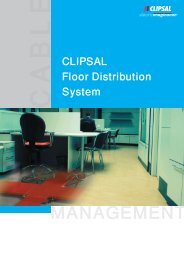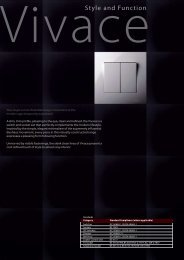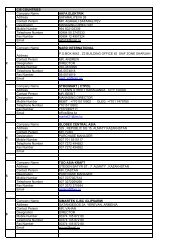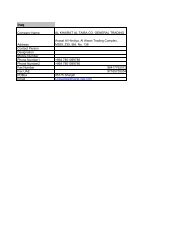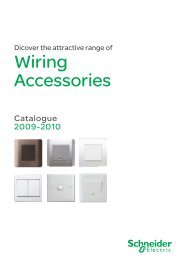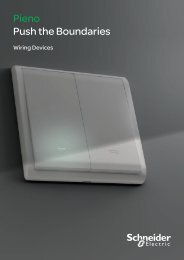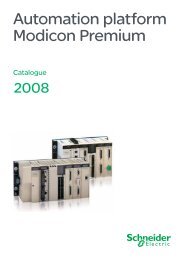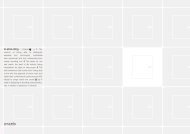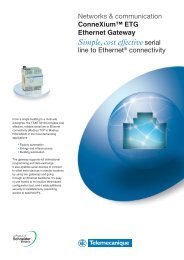Automation platform Modicon Premium - Schneider Electric
Automation platform Modicon Premium - Schneider Electric
Automation platform Modicon Premium - Schneider Electric
You also want an ePaper? Increase the reach of your titles
YUMPU automatically turns print PDFs into web optimized ePapers that Google loves.
1<br />
2<br />
3<br />
4<br />
5<br />
6<br />
7<br />
8<br />
9<br />
10<br />
Memory structure<br />
Slot PLC without PCMCIA memory card<br />
Internal RAM<br />
Internal RAM<br />
PCMCIA card<br />
slot no. 0<br />
1<br />
1<br />
2<br />
1/18<br />
3<br />
160 or 208 Kb<br />
160 to 208 Kb<br />
Located data<br />
Global and DFB<br />
unlocated data<br />
Program, symbols and<br />
area for online program<br />
modification<br />
Constants<br />
Slot PLC with PCMCIA memory card in slot no . 0<br />
Presentation:<br />
pages 1/14…<br />
128 to 7168 Kb<br />
Located data<br />
1<br />
Global unlocated data 1<br />
DFB unlocated data<br />
1<br />
Program and symbols<br />
2<br />
Constants<br />
Storage of additional<br />
data<br />
Description:<br />
pages 1/16 …<br />
3<br />
4<br />
1<br />
1<br />
2<br />
3<br />
<strong>Modicon</strong> <strong>Premium</strong><br />
automation <strong>platform</strong><br />
Atrium slot PLCs<br />
Unity<br />
Memory structure<br />
The application memory is divided into memory areas physically distributed in the<br />
internal RAM memory and on 0, 1 or 2 PCMCIA memory extension cards:<br />
1 The application data area, which may be one of 2 possible types, is always in the<br />
internal RAM:<br />
v Located data corresponding to data defined by an address (e.g. %MW237) to<br />
which a symbol may be associated (e.g. Counting_rejects).<br />
v Global unlocated data corresponding to data defined only by a symbol. This type<br />
of addressing removes memory “mapping” management constraints, as address are<br />
assigned automatically, and enables data to be structured.<br />
v DFB unlocated data, corresponding to data from DFB user function blocks. The<br />
size of this object zone is only limited by the size of the physical internal RAM<br />
memory available 1 (160 Kb or 208 Kb).<br />
2 Area in internal RAM or PCMCIA memory card for the program and symbols. In<br />
the event of this area being in internal RAM, it also supports the area for modifying<br />
the program in online mode (1).<br />
This area contains the program’s executable binary code and IEC source code.<br />
The user selects the type of information to be stored in the slot PLC memory.<br />
3 Constants area in the internal RAM or the PCMCIA memory card (slot no. 0)<br />
4 Storage area for additional data (slot no. 0 or no. 1), e.g. for production data and<br />
manufacturing recipes<br />
Memory organization<br />
Two memory structures are possible depending on whether the Atrium slot PLC is<br />
fitted with 0, 1 or 2 memory extension cards:<br />
b Application in internal RAM. In this case, the application is entirely loaded in the<br />
PLC slot’s internal battery-backed RAM (2), the capacity of which depends on the<br />
PLC slot model (160 Kb or 208 Kb).<br />
b Application in PCMCIA card. In this case, the internal RAM is reserved for<br />
application data. The PCMCIA memory card (slot no. 1) contains the program space<br />
(program, symbols and constants areas) (768 Kb or 1792 Kb).<br />
Certain types of PCMCIA memory card host the data storage area (max. 6976 Kb).<br />
Symbols areas<br />
The presence of the symbols area with the program area is optional. Having the<br />
application symbols database on the memory of the slot PLC means that, when<br />
connected to a programming terminal not containing any applications all the<br />
elements needed to debug or upgrade this PLC are available within the PLC.<br />
__________________________________________________________________<br />
(1) If a PCMCIA card has been inserted, the memory used by program modification in online<br />
mode is located in this memory card (outside zones 2, 3 and 4 opposite).<br />
(2) The internal RAM memory is backed up by an optional battery (3 years’ battery life) located in<br />
the power supply module (see page 2/2) .<br />
Characteristics:<br />
pages 1/20…<br />
References:<br />
pages 1/21 …<br />
PCMCIA references:<br />
pages 1/22 …


